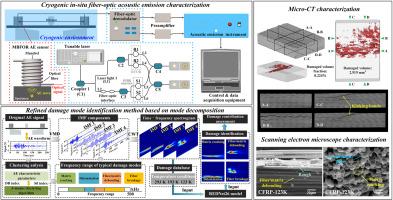基于原位光纤声发射和模态分解的CFRP复合材料在弯曲载荷下的低温损伤机理研究
IF 14.2
1区 材料科学
Q1 ENGINEERING, MULTIDISCIPLINARY
引用次数: 0
摘要
低温环境下复合材料的力学性能对结构可靠性提出了重大挑战。目前原位表征技术的局限性阻碍了对低温弯曲载荷下损伤演化机制的全面理解。为了解决这个问题,使用原位光纤声发射(AE)测试系统地研究了碳纤维增强聚合物层压板在低至123 K温度下的弯曲损伤行为。结合模态分解分析和一种新的深度学习算法,采用一种改进的损伤模式识别方法来阐明低温损伤机理。结果表明,低温环境显著降低了损伤起裂应变阈值,压缩了损伤模式间的时间间隔,从而促进了损伤发展的均匀化和机械能的耗散。虽然低温增强了树脂基体和基体-纤维界面的结合,但123 K时基体脆化明显降低了抗分层能力,是导致强度下降的关键因素。值得注意的是,改进的损伤识别方法在识别不同温度条件下的四种关键损伤模式方面达到了99%以上的分类准确率,同时有效地恢复了与纤维/基体脱粘和纤维断裂相关的隐藏信息。该研究促进了对复合材料低温损伤机制的理解,并为低温工程应用中的实时损伤评估建立了一个强大的框架。本文章由计算机程序翻译,如有差异,请以英文原文为准。

Cryogenic damage mechanism of CFRP laminates under bending load via in-situ fiber-optic acoustic emission and mode decomposition
The mechanical performance of composite materials under cryogenic environments presents significant challenges to structural reliability. Current limitations in in-situ characterization techniques hinder the comprehensive understanding of damage evolution mechanisms under cryogenic bending loads. To address this, flexural damage behavior of carbon fiber reinforced polymer laminates at temperatures as low as 123 K was systematically investigated using in-situ fiber-optic acoustic emission (AE) testing. A refined damage mode identification method, integrating mode decomposition analysis and a novel deep learning algorithm, was adopted to elucidate the cryogenic damage mechanisms. Results reveal that cryogenic environments significantly reduce the damage initiation strain threshold and compress the temporal intervals between damage modes, thereby promoting homogenization of damage development and the dissipation of mechanical energy. Although cryogenic temperatures strengthen the resin matrix and the bonding at the matrix-fiber interface, matrix embrittlement at 123 K markedly decreases the delamination resistance, serving as the key contributing factor to strength degradation. Notably, the refined damage identification methodology achieves over 99 % classification accuracy in identifying four critical damage modes across different temperature conditions while effectively recovering hidden information related to fiber/matrix debonding and fiber breakage. This study advances the understanding of cryogenic damage mechanisms in composite materials and establishes a robust framework for real-time damage assessment in cryogenic engineering applications.
求助全文
通过发布文献求助,成功后即可免费获取论文全文。
去求助
来源期刊

Composites Part B: Engineering
工程技术-材料科学:复合
CiteScore
24.40
自引率
11.50%
发文量
784
审稿时长
21 days
期刊介绍:
Composites Part B: Engineering is a journal that publishes impactful research of high quality on composite materials. This research is supported by fundamental mechanics and materials science and engineering approaches. The targeted research can cover a wide range of length scales, ranging from nano to micro and meso, and even to the full product and structure level. The journal specifically focuses on engineering applications that involve high performance composites. These applications can range from low volume and high cost to high volume and low cost composite development.
The main goal of the journal is to provide a platform for the prompt publication of original and high quality research. The emphasis is on design, development, modeling, validation, and manufacturing of engineering details and concepts. The journal welcomes both basic research papers and proposals for review articles. Authors are encouraged to address challenges across various application areas. These areas include, but are not limited to, aerospace, automotive, and other surface transportation. The journal also covers energy-related applications, with a focus on renewable energy. Other application areas include infrastructure, off-shore and maritime projects, health care technology, and recreational products.
 求助内容:
求助内容: 应助结果提醒方式:
应助结果提醒方式:


